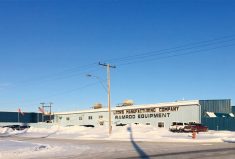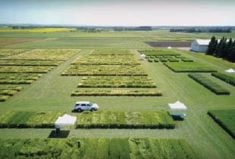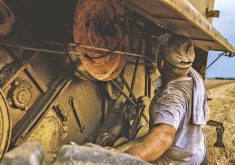When it comes to moving farm equipment on public roads, a little planning can go a long way towards preventing accidents.
“Farmers should check their route prior to starting out with farm equipment to be sure equipment will fit on all roads and bridges and that there are no low-hanging power lines along the route,” said Kenda Lubeck, farm safety co-ordinator with Alberta Agriculture and Forestry.
“If equipment is too wide to fit safely into one lane, approaching traffic could clip the machinery or become blocked while crossing a bridge. Equipment that is too tall could come in contact with a power line. Use a pilot vehicle as a guide for large machinery and to warn motorists of oncoming large equipment.”
Read Also

YEAR IN REVIEW: 2025 a year of weather extremes
Wildfires, drought and flash floods, oh my! Looking back at 2025’s headline-grabbing event in Canada and around the world.
For the safety of all motorists, it is highly recommended that farmers move equipment during high-visibility daylight hours and during periods of light traffic.
“Avoid busy roads whenever possible, even if travel time will be longer,” said Lubeck. “If your route takes you across a rural railway crossing, be aware that some crossings have poor visibility. Always stop and make sure the way is clear before crossing.”
Anyone moving equipment, especially on public roads, should be trained in how to use the equipment and must hold a valid driver’s licence.
“Inexperienced operators can make mistakes when they are not used to the speed and manoeuvrability limitations of farm equipment. It’s advisable to read the operator’s manual for each machine and observe any precautions indicated for road travel. Some tractors free-wheel in higher gears, which can be very dangerous when travelling down a hill. Use lower gear ranges when climbing or descending hills.”
As well, Lubeck said it’s important drivers never take extra riders on equipment.
“Extra riders on farm equipment are a distraction to the operator and are at risk of falling off the machinery and being run over. Each person in the machine should be secured with a seatbelt.”
Farm machinery operators can make road travel safer for themselves and others by observing safety precautions. Travel at a speed that will allow the operator to maintain full control at all times. Slow down when making turns or rounding curves. If needed, pull over when there is a suitable area to allow backed-up traffic to pass. Make sure the area is sufficiently wide and solid enough to handle the equipment.
“Never use a cellphone while transporting equipment,” added Lubeck. “The distracted driving law, along with all other rules of the road, are in full effect while driving farm machinery on public roads and highways.”
This and other information on the safe transportation of farm equipment on public roads is found in Make it Safe, Make it Visible, a publication available from Alberta Agriculture and Forestry. Visit agriculture.alberta.ca for more information on farm safety.















